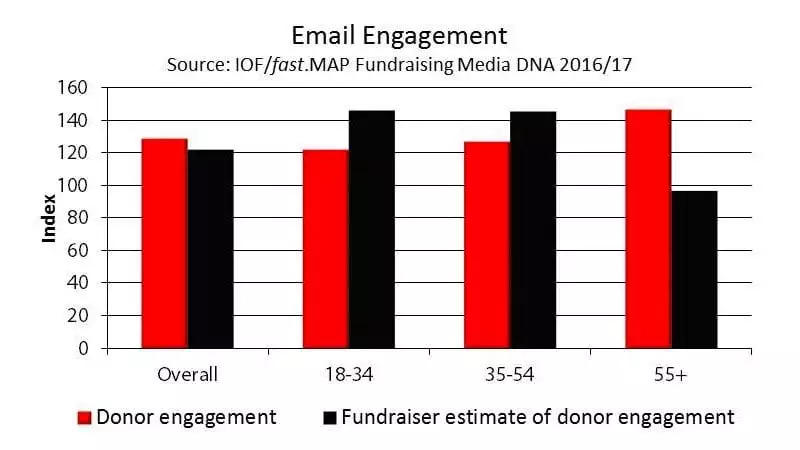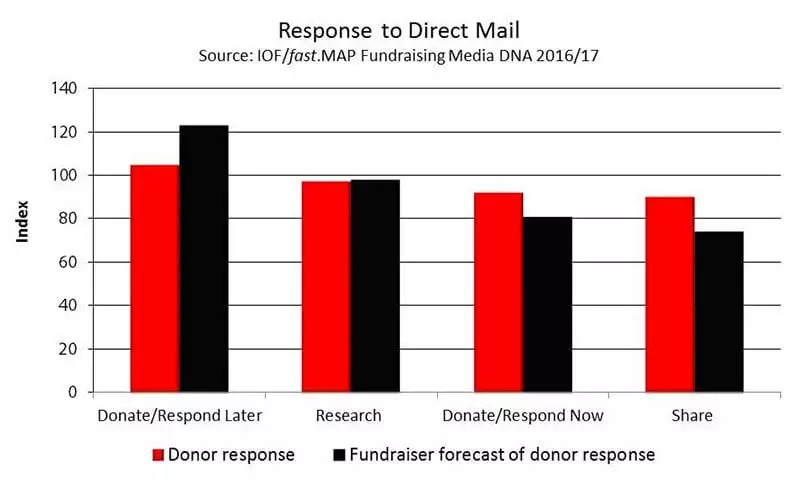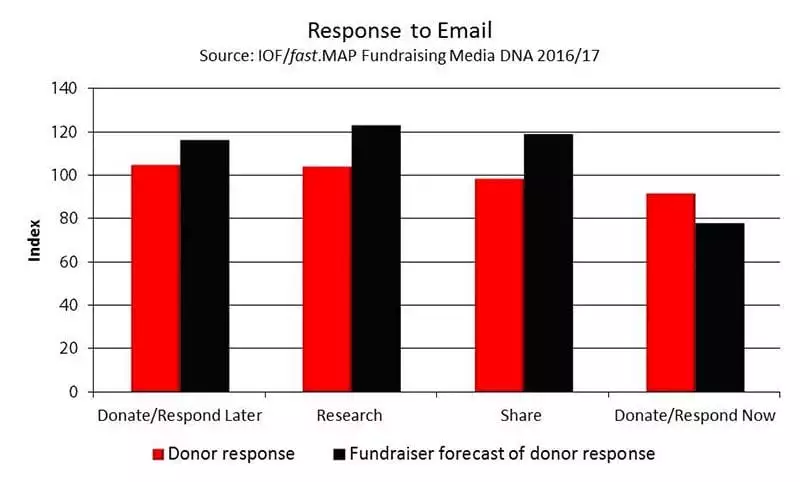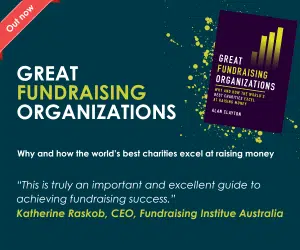Fundraising Media DNA – ‘old’ vs. ‘new’ media
fast.MAP’s Fundraising Media DNA report looks at the engagement levels of both ‘non-digital’ and ‘digital’ channels among donors.
Key Headlines
• Both traditional and non-traditional forms of media have the potential to encourage a very broad range of audiences; a perfect example is Direct Mail and Email
• As traditional channels, Press and Inserts are both seen as having a strong appearance and being interesting and attention grabbing
• Email, Social Media and SMS are generally more convenient, personalised and are more likely to be shared
• Download your copy of the Fundraising Media DNA report and Infographics using the free download code UKFU16
The engagement of different profiles with different media
Direct Mail has come out as the most engaging ‘non-digital’ channel, whilst Email performs the best as a ‘digital’ channel. Their mass appeal as fundraising channels is confirmed by the very high engagement level they achieve across all demographic profiles (Direct Mail Engagement Index: Overall, 122 vs. Email Engagement Index: Overall, 128).
Email is universally popular as a way of engaging with charities – but not always quite as popular as fundraisers think. They overestimate levels of engagement within younger age groups (Engagement Index, 18-34, Estimated 146 vs. Actual 122) and 35-54s (Engagement Index, 35-54, Estimated 145 vs. Actual 127).
Conversely, fundraisers expect over-55s to be least likely to react to Emails, but in fact, it is most popular among this group (Engagement Index, 55+, Estimated 97 vs. Actual 147). This discrepancy might be the result of stereotypically associating younger age groups with ‘New Media’ and older age ranges with ‘Old Media’.

Source: IoF/fastMAP Fundraising Media DNA 2016/17
Advertisement
What are the personality traits of ‘old’ and ‘new’ media?
‘Old’ media
As ‘non-digital’ channels, Press, Inserts and Direct Mail are all seen as having a strong appearance and as being interesting and attention grabbing.
Direct Mail scores highly for being retainable (Retainable Index: Overall, 141) and seems trustworthy (Trustworthy Index: Overall, 133) and relevant (Relevant Index: 127). Even though over-55s engage most with this channel, 18-34s also engage on an above average level (Engagement Index: 55+, 159 vs. 18-34s,109).
Press adverts are most highly rated for their visual strength and appearance (Appearance Index: Overall, 146). Press allows for enough space to include persuasive information and compelling images, which is not available on instant-info channels such as Social Media and SMS. For this reason, Press’ second highest attribute is interesting content (Interesting Index: Overall, 137).
Press ads are also perceived to be attention grabbing (Attention Index: Overall, 129), an aspect which is particularly the case for those who make small donations (Attention Index: Low donors, 140). This is perhaps useful for charities wishing to draw in new donors.
Inserts’ strongest attribute is their retainability (Retainable Index: Overall, 196), suggesting people like to keep them for reference. Donors also consider Inserts to be attention grabbing (Attention Index: Overall, 110), because they stand out from other marketing within a publication or mailing and have a ‘strong appearance’ (Appearance Index: Overall, 106).
‘New’ media
Fundraising Media DNA reports Email to be very convenient (Convenient Index: Overall, 141) and particularly easy to respond to (Ease of Response Index: Overall, 130). Social Media scores very highly for being easy to share with others (Share Index: Overall, 219). This is unsurprising, as it is easy to use, instantaneous and can be shared with scores of people at the touch of a button.
People also think of Email contact as personal (Personalised Index: Overall, 139) – particularly older donors (Personalised Index: 55+, 180). This is also true for SMS – it scores well above average for this attribute (Personalised Index: Overall, 145). This is perhaps unsurprising, since mobiles are now the ‘hub’ for the way in which more people access information, and the device is almost always with them.
Which channels drive donations?
According to Fundraising Media DNA, our non-digital methods of communication are the drivers of later responses/donations. The most likely response to Direct Mail, particularly for over-55s, is to donate or respond later (Donate/Respond Later Index: 55+, 115).

Source: IoF/fastMAP Fundraising Media DNA 2016/17
Likewise, Email recipients are also more likely to respond later rather than straight away, though fundraisers overestimate this potential (Respond Later Index, Overall, Estimated 116 vs. Actual 104), while underestimating its capacity to generate immediate donations (Donate/Respond Now Index, Estimated 78 vs. Actual 92). This presents charities with the challenge of creating memorable messages that encourage the supporter to take further action.

Source: IoF/fastMAP Fundraising Media DNA 2016/17
Whilst it is unsurprising that SMS and Social Media are great for sharing, most channels have the potential to encourage further research. Charities need to ensure they reinforce their messages, leading people to optimised landing pages to encourage a more immediate or positive response.
What do people say about different forms of media?
“More traditional media, such as Direct Mail, Press and Insert, still play a key role in engaging a wide range of audiences, including younger donors as well as the over 55s. Gaining donor consent to receive communications is a complex issue, with different groups motivated to give it for different reasons – and preferences vary channel-to- channel too. Therefore, it is crucial to research the merits of each channel and how, e.g. digital and non-digital fundraising complement each other.”
David Cole, Managing Director, fast.MAP
“As fundraisers and charities review what they are doing, the information and insight that reports like Fundraising Media DNA brings is invaluable. The more we know about how engaged supporters and active donors respond to different fundraising channels, the more that we can plan great campaigns that inspire people.”
Daniel Fluskey, Head of Policy Research, Institute of Fundraising
“The research and evidence in this report will help guide the thinking and development of the recommendations arising from the Commission. The subtle differences between channels – and indeed between the ways that fundraisers and donors look at and engage with these channels – will help fundraisers nuance the approach to using different channels and better understand how to put the donor back at the heart of fundraising.”
Richard Spencer, Director, The Commission on the Donor Experience
“Rather than focus solely on what distinguishes these channels from each other, it is equally useful to reflect on what unites them. To create seamless supporter journeys, it’s essential to synchronise channels and make them work together, harnessing what each does best.”
“Tapping into the different modes of interaction with each channel, but understanding that many people will engage with you across them all for different reasons, is critical to a joined-up experience.”
Dan Martin, Digital Strategy Director, WPN Chameleon and on behalf of the Commission of the Donor Experience
To find out more about how people view and interact with different fundraising channels, download Fundraising Media DNA 2016/17 – free, (normally £50) with the following code: UKFU16.



